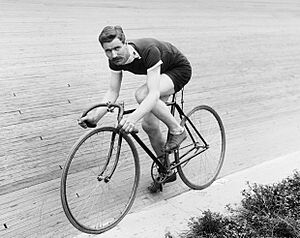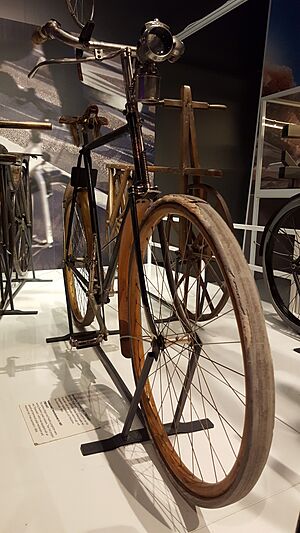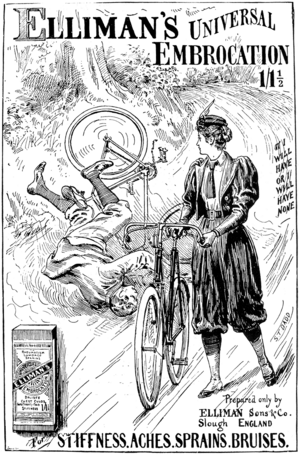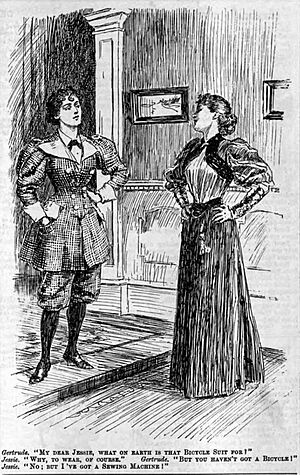History of cycling facts for kids
Cycling is a super popular activity that started in the 1800s when bicycles first came out. Today, over a billion people around the world ride bikes for fun, to get around, and for sports!
Contents
Bicycle Racing: The Start Line
The very first bike race that we know about happened on May 31, 1868. It was a 1,200-meter race in Paris, France. An Englishman named James Moore won it, riding a bike with solid rubber tires. James Moore also won the first race between two cities, riding 123 kilometers from Paris to Rouen in 10 hours and 40 minutes!
In the United States, the oldest bike racing club is the St. Louis Cycling Club. It's been around since 1887! This club has organized many races and timed events. Many of its members have become national champions and even joined the Olympic team.
Riding for Fun: Recreation
People started riding bikes just for fun soon after racing began. In the early days, cycling allowed young men and women to spend time together without someone watching them closely. This became even more common after the 1880s when the "Rover Safety bicycle" made bikes easier and safer to ride. Some people worried about this new freedom, especially as women's cycling clothes became less formal and restrictive.
In 1915, a group in the Netherlands started a society to build special paths for bikes. They thought that the growing number of cars made it too dangerous for people to cycle for fun. They wanted bike paths that were separate from car roads. These paths would also be designed for enjoyment, not just the shortest way to get somewhere.
Biking to Work: Commuting
Riding bikes to work has been a thing since the 1890s. In the United States, this was common until the 1920s. Then, fewer people biked because more people lived in suburbs and cars became very popular. In Europe, cycling to work stayed common until the late 1950s.
Today, many people ride bikes to work for different reasons. It's great for fitness, good for the environment, and can save money. It's also just plain fun! In 2008, about 0.55 percent of Americans used a bike as their main way to get to work. Some workplaces even help bike commuters by offering showers, changing rooms, and safe places to park bikes.
Long Journeys: Touring
Many cyclists loved using their bikes to travel far distances. Some even rode their bikes all the way around the world! Annie Londonderry was the first woman to do this in 1894–95, and it took her 15 months. In the 1920s, six men from India cycled 71,000 kilometers around the world.
The Bicycle Craze
Bicycles became super popular in Europe and North America in the late 1800s. This was because new bikes were much better than older ones like the "penny-farthing." They were easier to steer, safer, more comfortable, and faster. The new bikes were also the first ones that were good for women to ride. Because of this, American feminist Susan B. Anthony called the bicycle the "freedom machine." She said it gave women "a feeling of freedom and self-reliance."
The Svea Velocipede was a special bike made in 1892 by Swedish engineers Fredrik Ljungström and Birger Ljungström. It had unique pedals and was shown at the World's Fair. Thousands of these bikes were made.
Bike historians often call this time the "golden age" or "bicycle craze." By the early 1900s, cycling was a major way to get around. In the United States, it also became a very popular way to have fun. Bike clubs for both men and women popped up all over the U.S. and Europe.
An immigrant in Chicago named Adolph Schoeninger helped make bikes much cheaper. He used new ways to make bikes in large numbers, similar to how Henry Ford later made cars. This made bikes affordable for many working people. His "Crescent" bikes were even exported to Europe, lowering prices there too.
Women and Cycling: A New Freedom
The bicycle had a huge impact on women's freedom. Safer and cheaper bikes gave women a new way to move around on their own. This helped them take a bigger part in society. The bicycle became a symbol of the "New Woman" of the late 1800s, especially in Britain and the United States.
Many people who supported women's rights saw how powerful the bicycle was. Susan B. Anthony famously said, "I think it has done more to emancipate women than anything else in the world. It gives women a feeling of freedom and self-reliance."
In 1895, Frances Willard, a leader of the Women's Christian Temperance Union, wrote a book about learning to ride a bike. She loved her bicycle, which she named "Gladys," saying it made her feel happy and hopeful. She used cycling as a way to encourage other women to take action for their rights. Elizabeth Robins Pennell started cycling in the 1870s and wrote many travel books about her bike trips around Europe. In 1895, Annie Londonderry became the first woman to cycle around the world.
Because women couldn't ride bikes easily in their long, restrictive dresses, the "bicycle craze" also led to new fashion. This was called "rational dress." It helped free women from tight corsets and long skirts. Instead, they started wearing "bloomers," which were quite shocking at the time!
See also
- History of the bicycle
- Pope Manufacturing Company
- Cyclability






